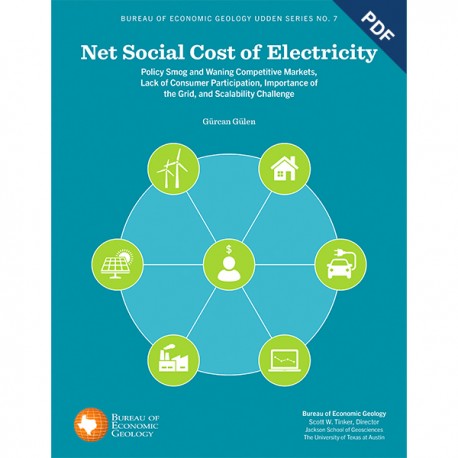Udden Series
-
Books & Reports
- Reports of Investigations
- Guidebooks
- Udden Series
- Geological Circulars
- Down To Earth
- Atlases of Major Oil and Gas Reservoirs
- Texas Memorial Museum Publications
- Environmental Geologic Atlas of the Texas Coastal Zone
- Mineral Resource Circulars
- Other Reports
- Seminars and Workshops
- Handbooks
- Submerged Lands of Texas
- Symposia
- Annual Reports
- Open File Reports
-
Maps & Cross Sections
- Thematic Maps
- Miscellaneous Maps, Charts & Sections
- Geologic Atlas of Texas
- STATEMAP Project Maps
- Geologic Quadrangle Maps
- Cross Sections
- Highway Geology Map
- Energy and Mineral Resource Maps
- Shoreline Change and Other Posters
- Wilcox Group, East Texas, Geological / Hydrological Folios
- Bouguer Gravity Atlas of Texas
- River Basin Regional Studies
- Featured Maps
- Posters
- Teachers & the Public
-
Geological Society Publications
- Gulf Coast Association of Geological Societies
- Alabama Geological Society
- Austin Geological Society
- Corpus Christi Geological Society
- Houston Geological Society
- Lafayette Geological Society
- Mississippi Geological Society
- New Orleans Geological Society
- South Texas Geological Society
- GCS SEPM Publications
- Historic BEG & UT Series

Net Social Cost of Electricity - Digital Download
US0007D
Net Social Cost of Electricity: Policy Smog and Waning Competitive Markets, Lack of Consumer Participation, Importance of the Grid, and Scalability Challenge, by Gürcan Gülen. 86 p., 21 figs., 5 tables, 2019. Digital Version.
For a print version: US0007.
US0007D. Net Social Cost of Electricity: Policy Smog and Waning Competitive Markets, Lack of Consumer Participation, Importance of the Grid, and Scalability Challenge, by Gürcan Gülen. 86 p., 21 figs., 5 tables, 2019. Downloadable PDF. doi.org/10.23867/US0007D
To purchase this publication in book format, please order US0007.
About This Publication
The purpose of this report is to demonstrate that the time is ripe for a rational, multifaceted, fresh look at the technology, economics, and negative as well as positive externalities of electricity service in the United States.
Electricity markets face a policy-driven energy transition that threatens the financial sustainability of many businesses across the electric-power value chain. There are many efforts to adapt the markets to out-of-market policies that support a preferred mix of available technologies rather than targeting ultimate goals such as lower emissions, affordable electricity, and reliable service. But these attempts undervalue the role of consumers in reducing system costs and fueling true innovation. Worse, the current uncoordinated, blunderbuss approach to energy policy across numerous jurisdictions has turned into a political competition of “leveling the playing field” for favorite technologies via subsidies and mandates. Many of these policies and attendant market design changes lead to litigation, which raises the cost of electricity to customers, increases uncertainty for market participants, and encourages further rent-seeking.
This report argues for a return to competitive principles with a policy that focuses on ultimate goals rather than technologies and that fully incorporates consumers into the market.
About the Author
Gürcan Gülen has more than 25 years of global experience in research, technical assistance, and capacity building in oil, natural gas, and electric power value chains. His electric power research includes comparative assessment of legal and regulatory frameworks for competitive electricity markets across numerous jurisdictions; dispatch modeling to investigate the future role of various generation technologies under various scenarios and to assess their impacts on electricity prices, generator revenues, and emissions; analysis of impacts of changes to energy market designs on real-time prices and out-of-market uplift payments; study of improvements on levelized cost of electricity estimates; and determination of per-megawatt-hour value of federal and state subsidies for different generation technologies. He has published numerous reports and book chapters. He holds a Ph.D. in Economics from Boston College and a B.A. in Economics from Bosphorus University, Istanbul, Turkey.
Contents
Acknowledgments
Executive Summary
Prologue
Costs of the Current State of Limbo
Potential for Improvement of Benefit–Cost Transparency?
Part I—Electricity as a Public Service and Competitive Markets
Principles of a Competitive Electricity Market
Electricity Grid and Market: A Precise Balancing Act
Erosion of Competitive Markets
Price Caps and Limited Demand-Side Participation
Subsidies
Resource Adequacy, “Out-of-Market” Support, Missing Money, and Market Reforms
Delivering ___?___ Electricity
Market-IRP: A Planned Market
Part II—A Fresh Look at the Social Cost of Generation Resources
Generation Costs
Regional Differences
Wide Range of Levelized Cost of Electricity Estimates
A More Complete Levelized Cost of Electricity
Externalities
System-Integration Costs
Subsidies
Levelized Cost of Electricity as a Policy Tool
Epilogue
The Future of Electricity
References
Figures
1. Fifteen-minute real-time load, wind generation, and energy prices in the Electric Reliability Council of Texas (ERCOT)
2. Load duration and net load duration with wind in ERCOT, 2017
3. Hour-to-hour changes in load and net load in ERCOT, 2015–17
4. Twenty-four-hour volatility of load and net load in ERCOT, 2015–17
5. Historical and forecast U.S. wind-capacity additions
6. Cycle of subsidy dependency in the solar industry
7. Regional wholesale energy market value of wind and generation-weighted national average levelized wind-power purchase-agreement prices
8. 2017 operating reserve demand curves (ORDC) in ERCOT triggered at 2,000 MW
9. Options for organizing electric power sector
10. Wind speed and solar resources in the United States
11. Wide range of recent levelized cost of electricity (LCOE) estimates, excluding externalities, system-integration costs, and subsidies ($/MWh)
12. Representative U.S. LCOE, including air emissions ($/MWh)
13. Wind integration costs at various penetration levels for various U.S. systems
14. U.S. average retail electricity prices (cents/kWh) and wholesale electricity price ($/MWh)
15. Index of retail prices, wholesale price, and transmission and distribution (T&D) capital and operation expenses
16. Changes in real-time nonwind nodal prices ($/MWh) in ERCOT, 2015–16
17. Gas-fired plant revenue changes in ERCOT under hypothetical wind constraint scenarios
18. Solar overproduction in California
19. Wind-integration costs in a typical thermal system in Europe at various penetration levels
20. Representative U.S. LCOE with air emissions and system-integration costs ($/MWh)
21. Representative U.S. LCOE with air emissions, system-integration costs, and federal direct and tax subsidies ($/MWh)
Tables
1. Capacity factor assumptions, technical estimates, and historical data
2. Representative levelized costs of electricity (LCOEs)
3. Sample studies on balancing costs
4. Sample studies on grid costs
5. Electric power options, objectives, and considerations
Keywords: electricity market, competition, regulation, vertical integration, transmission and distribution, market design, real-time energy price, forward capacity market, integrated resource planning, energy policy, policy failure, externalities, price cap, demand-side participation, demand response, out-of-market support, renewable portfolio standards, tax credits, mandates, rent-seeking, levelized cost of electricity (LCOE), system integration cost, augmented LCOE, resource adequacy, benefit–cost analysis, stranded costs
Citation
Gülen, Gürcan, 2019, Net Social Cost of Electricity: Policy Smog and Waning Competitive Markets, Lack of Consumer Participation, Importance of the Grid, and Scalability Challenge: The University of Texas at Austin, Bureau of Economic Geology, Udden Series No. 7, 86 p. doi.org/10.23867/US0007D

